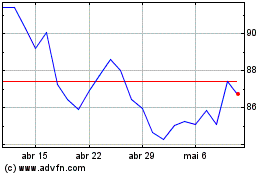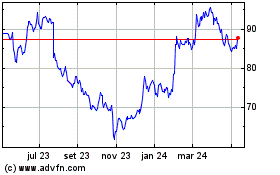Large, Real-world Studies Demonstrate Continued Excellent Outcomes for Patients Receiving Edwards SAPIEN TAVR
11 Março 2024 - 3:00PM
Business Wire
Edwards Lifesciences (NYSE: EW) announced today at
Cardiovascular Research Technologies (CRT) 2024 the compelling
results from two large, real-world studies based on TVT Registry
data that demonstrated continued excellent outcomes for patients
treated with the Edwards SAPIEN valve platform.
A study of Edwards’ latest TAVR technology, the SAPIEN 3 Ultra
RESILIA valve, found lower rates of paravalvular leak (PVL) at 30
days, lower echo-derived gradients and larger effective orifice
areas across all valve sizes when compared to the SAPIEN 3 and
SAPIEN 3 Ultra valves. These data were presented yesterday during a
podium presentation and simultaneously published in the Journal of
the American College of Cardiology (JACC): Cardiovascular
Interventions. In a second study presented during the late-breaking
clinical trials session, small Edwards SAPIEN TAVR valves
demonstrated equally excellent outcomes at 3 years as compared to
larger SAPIEN TAVR valve sizes.
“These real-world data further add to the robust body of
evidence on the performance of Edwards SAPIEN TAVR and highlight
the meaningful advancements of the SAPIEN 3 Ultra RESILIA valve,
which provides patients with severe aortic stenosis the leading
option for true lifetime management of their heart valve disease,”
said Larry Wood, Edwards’ corporate vice president and group
president, transcatheter aortic valve replacement and surgical
structural heart.
Real-World Results of the SAPIEN 3 Ultra RESILIA
Valve
In a study of real-world evidence of patients from the TVT
Registry, researchers compared the outcomes of more than 10,000
patients across more than 800 sites in the United States treated
with the SAPIEN 3 Ultra RESILIA valve to those receiving SAPIEN 3
Ultra and SAPIEN 3 valves using procedural and hemodynamic data and
clinical outcomes for propensity-matched cohorts.
The study found that all Edwards TAVR platforms demonstrated
excellent PVL results. Notably, there was a statistically
significant reduction in PVL for the 29 mm SAPIEN 3 Ultra RESILIA
valve as compared to the 29 mm SAPIEN 3, with 88.3% of patients
exhibiting no PVL and only 10.7% of patients exhibiting mild PVL.
The SAPIEN 3 Ultra RESILIA valve was also associated with
significantly lower echocardiography-derived mean gradients and
larger effective orifice areas across all four valve sizes with low
rates of all-cause mortality, cardiac death, all stroke,
life-threatening bleeding, major vascular complications, and
permanent pacemaker implantation in-hospital or at 30 days.
Late-Breaking Clinical Results Comparing Small Edwards TAVR
Valves to Larger Valves
An analysis of 8,100 propensity matched patients across more
than 800 sites in the United States found that patients treated
with a 20mm Edwards SAPIEN valve demonstrated excellent all-cause
mortality and stroke outcomes at 3-years, equivalent to those
receiving 23, 26 and 29mm SAPIEN valve sizes. Among mortality
indicators, researchers concluded that while PVL and new permanent
pacemaker implantation were both associated with increased
mortality, the relationship between post-procedural echo-derived
mean gradients and clinical outcomes is nonlinear and more
complex.
“This examination of these real-world data gives us important
insights into the actual performance of small Edwards valves and
reaffirms the excellent outcomes for patients receiving SAPIEN
TAVR, regardless of valve size,” said Amr Abbas, MD, Professor of
Medicine at Oakland University William Beaumont School of Medicine,
Director of Structural Heart at Corewell Health East, William
Beaumont University Hospital and principal investigator in the
small SAPIEN valve study.
About Edwards
Lifesciences
Edwards Lifesciences is the global leader of patient-focused
innovations for structural heart disease and critical care
monitoring. We are driven by a passion for patients, dedicated to
improving and enhancing lives through partnerships with clinicians
and stakeholders across the global healthcare landscape. For more
information, visit Edwards.com and follow us on Facebook,
Instagram, LinkedIn, Twitter and YouTube.
This news release includes forward-looking statements within the
meaning of Section 27A of the Securities Act of 1933, as amended,
and Section 21E of the Securities Exchange Act of 1934, as amended.
These forward-looking statements include, but are not limited to,
statements made by Mr. Wood and statements regarding expected
product benefits, patient outcomes, post-treatment reduction of
invasive procedures, objectives and expectations and other
statements that are not historical facts. Forward-looking
statements are based on estimates and assumptions made by
management of the company and are believed to be reasonable, though
they are inherently uncertain and difficult to predict. Our
forward-looking statements speak only as of the date on which they
are made, and we do not undertake any obligation to update any
forward-looking statement to reflect events or circumstances after
the date of the statement. Investors are cautioned not to unduly
rely on such forward-looking statements.
Forward-looking statements involve risks and uncertainties that
could cause results to differ materially from those expressed or
implied by the forward-looking statements based on a number of
factors as detailed in the company's filings with the Securities
and Exchange Commission. These filings, along with important safety
information about our products, may be found at Edwards.com.
Edwards, Edwards Lifesciences, the stylized E logo, Edwards
SAPIEN, Edwards SAPIEN 3, Edwards SAPIEN 3 Ultra, RESILIA, SAPIEN,
SAPIEN 3, and SAPIEN 3 Ultra are trademarks of Edwards Lifesciences
Corporation. All other trademarks are the property of their
respective owners.
View source
version on businesswire.com: https://www.businesswire.com/news/home/20240311956441/en/
Media Contact: Howard Wright, 949-250-2790 Investor
Contact: Mark Wilterding, 949-250-6826
Edwards Lifesciences (NYSE:EW)
Gráfico Histórico do Ativo
De Mar 2024 até Abr 2024

Edwards Lifesciences (NYSE:EW)
Gráfico Histórico do Ativo
De Abr 2023 até Abr 2024
